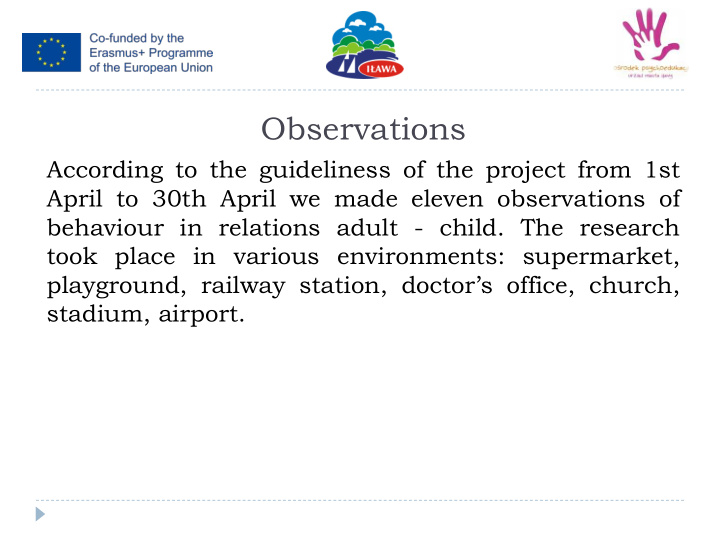



Observations According to the guideliness of the project from 1st April to 30th April we made eleven observations of behaviour in relations adult - child. The research took place in various environments: supermarket, playground, railway station, doctor’s office, church, stadium, airport.
1. Stadium (football match) Whole families went to see the match to spend some free time in an active way. The event positively affected relations in the families – bonding, common interests. Parent took care of health and safety of their children. In some individual cases we could observe (father – son) that father was teaching his son bad habits and aggression giving bad example.
2. Supermarket During shopping children often mirror the behaviour of parents by putting products into the trolley. When a parent notices the situation they often react with a suddent burst of anger without explaining correct behaviour. The child often feels ashamed and starts crying. The whole situation repeats several times. It is a clear form of verbal violence.
3. Airport Grandparents are waiting for their grandchildren to come back from abroad. There is a lot of happiness and laughter during the welcoming. A lot of affection between adults and children.
4. Family event During a family event in town children and parents were walking along stalls with toys and baloons. During the observation we have noticed healthy relations between parents and children – showing affection. Conflict situation, when one of the children wanted a toy, was resolved very quickly. Parents patiently but firmly explained why they are not going to buy the toy.
5. Railway station Parents and children are waiting for the train. Children are asking a lot of questions. Parents listen very carefuly and answer patiently every question. They are definitely interested in what the children are saying.
6. Doctor’s place A child is very nervous and bored while waiting for an appointment. As a result he is acting very loud just to attract parent’s attention. The parent is forcing the child to be quiet, she does not explain how he should behave.
7. Park Family is spending actively free time in the park. The children are fighting over a toy. When the children cannot solve the problem themselves the parents react to the situation and explain to them rules of common play.
8. Church (Holy Mass) During the mass bored child is walking and running in the church singing her favourite songs. The parent reacts quickly and in a calm way, explains the right behaviour. When the child starts to act loudly again they go out of the church.
9. Family event During the family event parents provided their children with proper meals. Children had a lot of tim for themselves and they were having good time. Every question was answered.
10. Supermarket Child has a stomach ache and she is crying. She says she wants to go home. The parent is very concerned and finishes shopping very quickly all the time takig care of the child.
11. Playground Child asks mother for permission to go to the shop. Mother reacts after a while. You can notice lack of interest. In consequence, she doesn’t allow her child to go to the shop, she doesn’t give reasons why.
Conclusions Adults’ sensitivity to children’s requests and complaints o They immediately react and listen in an active way – 6x o They react with a delay, they show lack of interest – 3x o It does not occur – 2x How do parents solve conflicts between children? o Parents’ intervention – 1x o Children solved the problem themselves – 1x o It does not occur – 9x
Conclusions Do parents show affection? o Yes– 8x o No – 3x Is there unhealthy behaviour in the location: smoking or drinking alcohol? o Yes – 3x o No – 8x
Conclusions Do adults behave correctly in the presence of children (do they shout, use curse word or other inappropriate behaviour) o Yes – 7x o No – 4x Do adults answer/ explain the children’s questions or just reject them? o Yes – 8x o No – 3x
Conclusions Are there any forms of violence in relation to children: physical, verbal, silencing, ignoring? o Yes, silencing – 2x o Yes, ignoring – 1x o No – 8x
Conclusions During the observations we mainly paid attention to the behaviour of parents towards their children. In the majority of cases we could observe a positive image of parents. Nowadays, living in constant rush parents are aware that child needs their presence, warmth and also clearly set rules and values. We have to also mention the two situations – one very positive and one negative.
Conclusions The first situation took place was observed at the railway station. It showed in a simple way correct contact between an adult and a child. Despite many questions parents actively listened to their children, showing their interest. They all felt they belong to the family.
Conclusions Totally different approach was visible during the situation in the supermarket where the child was putting products into the trolley. In this case the parent raises her voice and shouts at the child. The child is crying and feels ashamed. After that the child is left alone without any explanation and the situation repeats several times.
Summary of observations Taking into consideration those two behaviours it is easy to see how important in a child’s life is to be noticed by the parent, who should be a role model. That is why it is important to introduce our children to clear rules and values, which are respected also by parents. We can distinguish two different behaviours of parents towards their children: positive – showing feelings, listening and reacting; negative – lack of empathy, lack of empathizing with children, lack of understanding and verbal aggression.
Recommend
More recommend